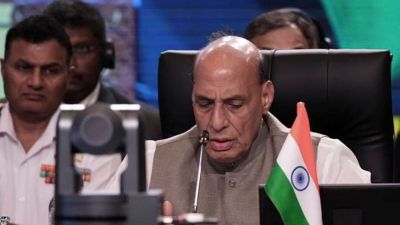Safety Measures
An analysis of India’s security apparatus by a man who has spent a lifetime in governance.
 Vice President Hamid Ansari releasing the book ‘Safeguarding India’ written by the Governor of J&K NN Vohra, in New Delhi. (Source: http://vicepresidentofindia.nic.in/)
Vice President Hamid Ansari releasing the book ‘Safeguarding India’ written by the Governor of J&K NN Vohra, in New Delhi. (Source: http://vicepresidentofindia.nic.in/)
Book: Safeguarding India: Essays on Governance and Security
Author: NN Vohra
Publisher: Harper Collins
Pages: 196
Price: Rs 499
At first glance, the book presents a rather mundane narrative — one wonders why identical lectures and essays, presented to multiple audience over the years, are compiled with slightly tinkered titles. But, as one reads on, one begins to notice the unprecedentedly incisive, indeed scathing, assertions of a seasoned bureaucrat who holds the distinction of having served as India’s defence secretary, home secretary, principle advisor to the Prime Minister, and who is today the longest serving governor of India’s most turmoil-ridden province — Jammu & Kashmir. By the time one finishes reading this book, one begins to appreciate not just the candour but the anguish of a man who has served a lifetime in governance, dealing with both internal and external aspects of the national security apparatus.
Safeguarding India also validates the dictum that the “more we change, the more we remain the same” as most of these lectures, chapters and op-eds, written by NN Vohra from 1996 to 2014, remain valid in 2016. Reflecting his simple yet decisive style, he begins with the commonplace assertion that internal and external security remain “inextricably intermeshed”. But he uses this to present the rather startling conclusion that “the home ministry cannot be relied upon even for effective coordination” as it “no longer manages IAS cadre or controls the functioning of CBI.” He further elaborates that the budget of IB remains secret, exempt from scrutiny, and the director of IB “alone knows what his officers are doing.” On Pakistan as well, he contends that India “has not displayed any interest in putting aside, at least, the less intricate security-related problems…[and] India’s approach to the resolution of the Sir Creek and Tulbul issue has not been any more energetic.” He says that “by end-1992, both sides had agreed to pull out of the Siachen glacier and demilitarise the area…[but] That day never came.” His 1997 essay on ‘Security in the Indian Ocean’ says, “[W]hile China’s assertive policies in the South China Sea have gained international notice, its increased interest in the seas around India has not been adequately observed” — worthy of being today’s headlines.
As regards governance, with over 600 political parties registered in India, he believes that the “electoral process has become increasingly expensive, debased and criminalised” with leaders having progressed from “beseeching…to demanding and even extorting payments.” It “has, over time, led to the replacement of the rule of law with patronage, nepotism and corruption.” Police functions under the colonial Police Act of 1861 has been politicised and communalised and “80 per cent of the annual state police budgets go towards meeting salaries and pensions” leaving little for training and equipment. In 1993, the Vohra Committee report had underlined the existence of a nexus of criminals, government functionaries and politicians. Today, Vohra says, not only “no tangible remedial action has materialised so far”, but “recurring reports of billions of rupees being laundered or millions of rupees being seized in raids conducted by the enforcement agencies do not cause any special concern to the cabinet or parliament.”
In the end, the book presents a powerful analysis and urges action, but it does not suggest any remedies except calling for “depoliticisation of the functioning of the police organisations and strengthening of their intelligence wings”, “inducting representatives of the states in the National Security Advisory Board and the National Security Council.” This is because he sees “rays of hope” in expanding social and media activism and the role of institutions like the courts or human rights commissions, though they also remain vulnerable to inducements, unfettered egos and logistical inadequacies.






- 01
- 02
- 03
- 04
- 05





















